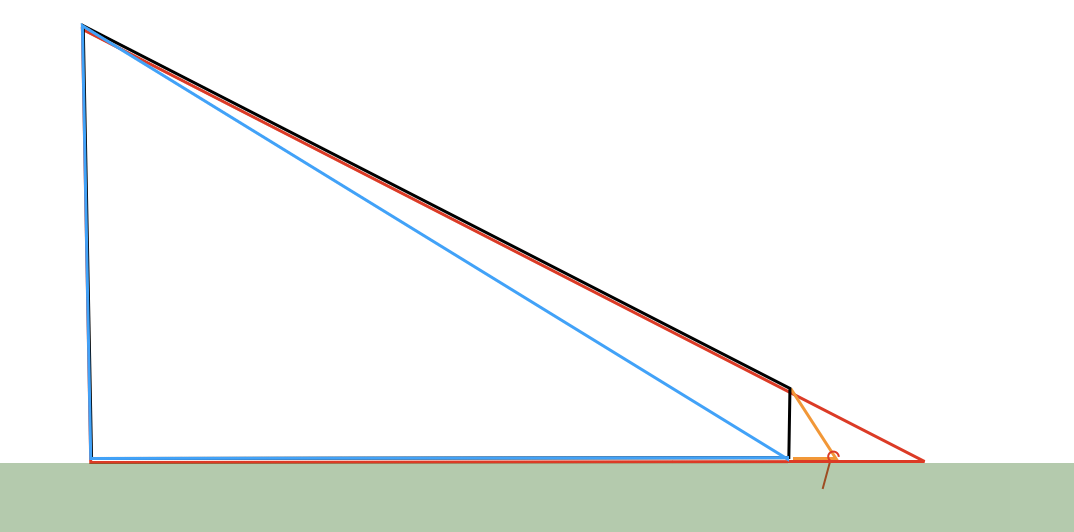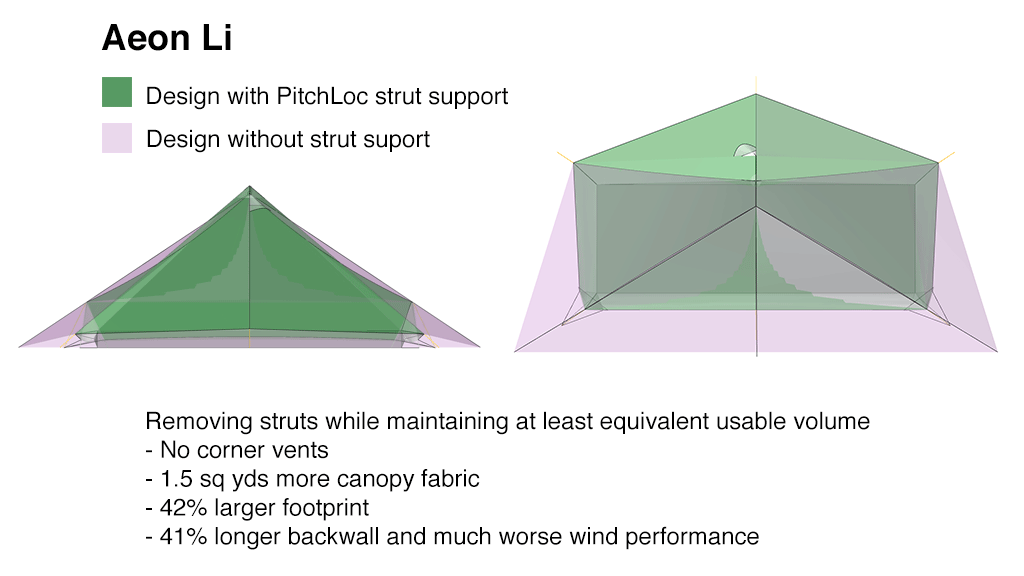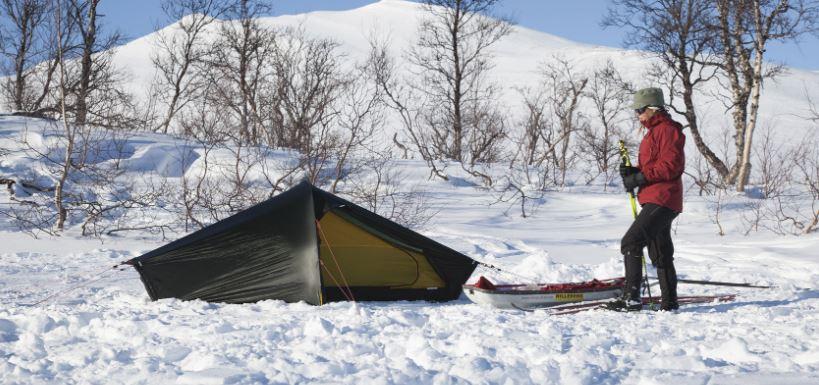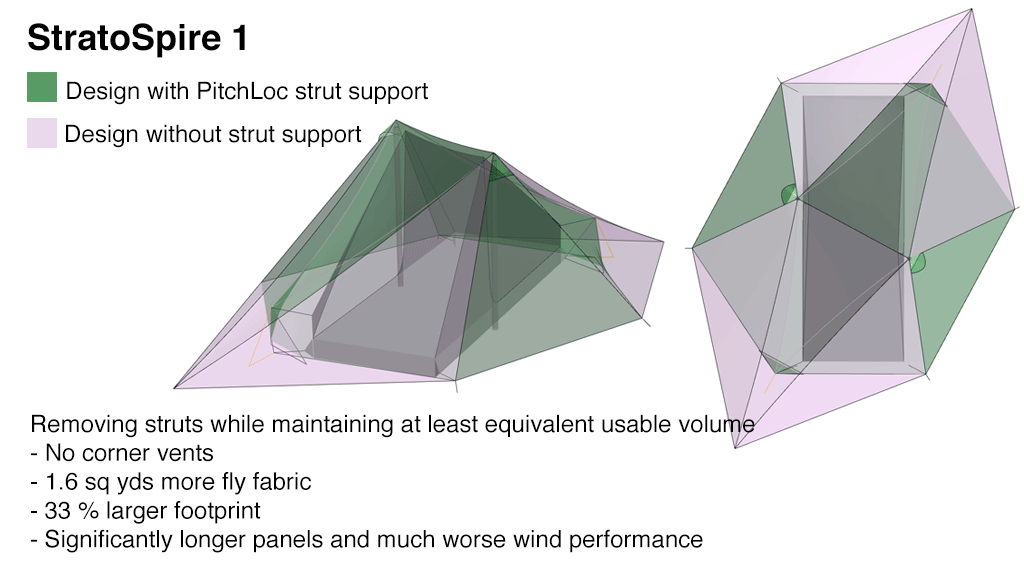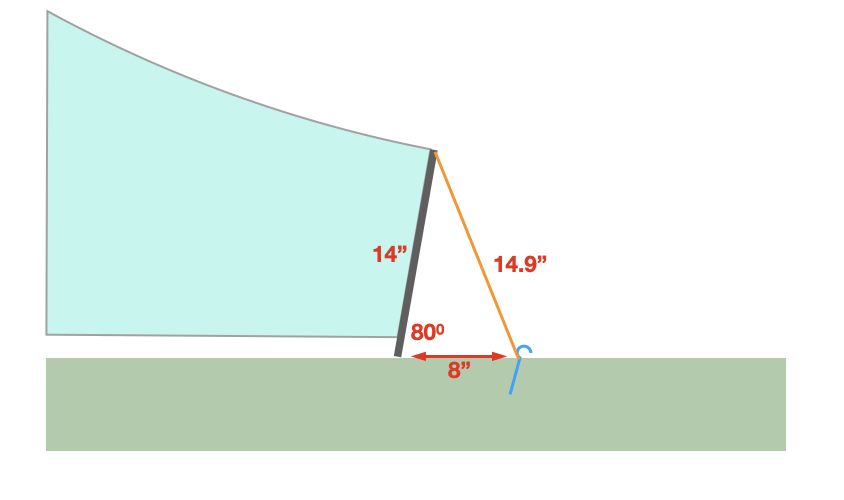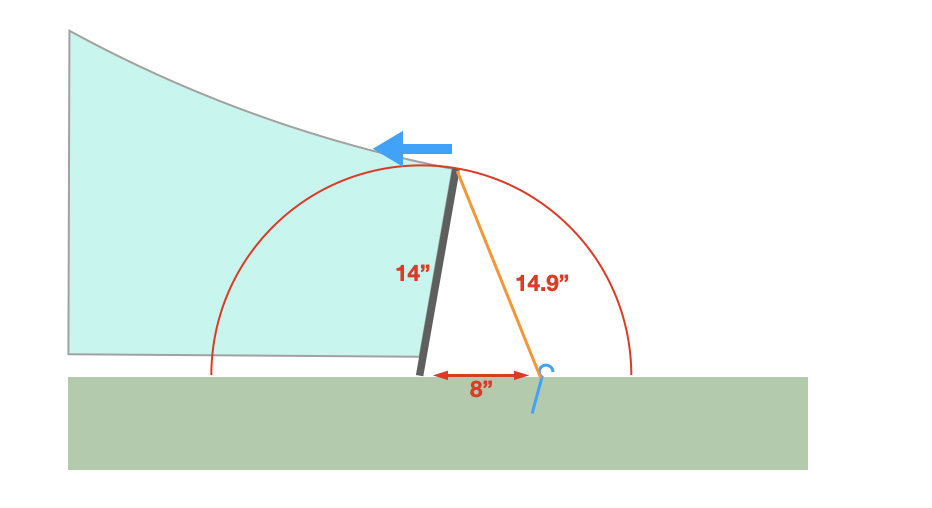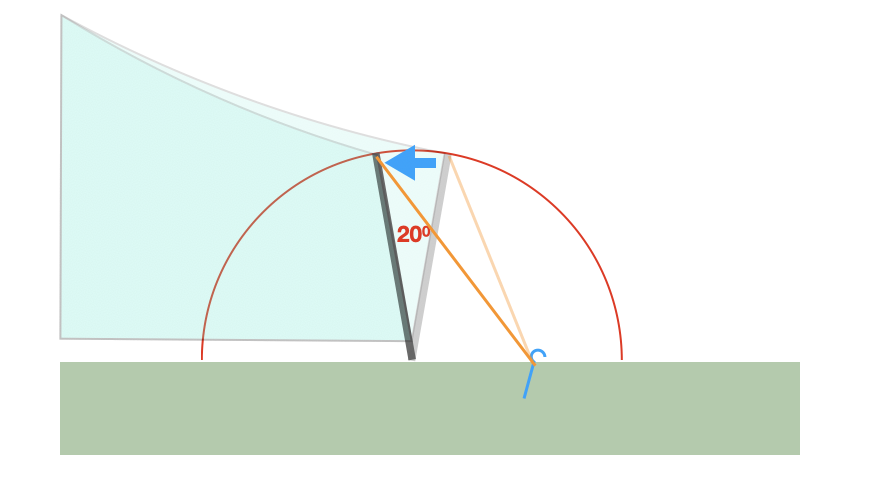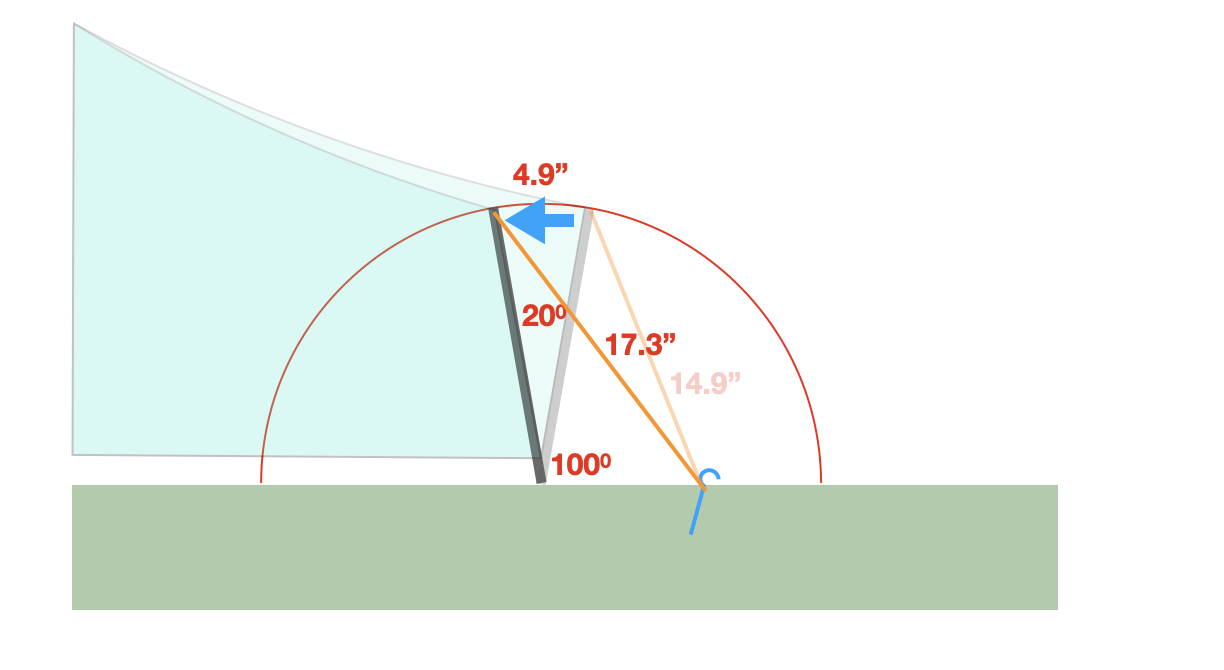Topic
So I have a new Tent plan for 2021…input welcome
Forum Posting
A Membership is required to post in the forums. Login or become a member to post in the member forums!
Home › Forums › Gear Forums › Gear (General) › So I have a new Tent plan for 2021…input welcome
- This topic has 176 replies, 35 voices, and was last updated 4 years, 2 months ago by
 Roger Caffin.
Roger Caffin.
-
AuthorPosts
-
Dec 3, 2020 at 4:06 am #3686979
I was under the assumption that the pitch lock corners also added some rigidity to the tent so less stake outs were needed (mid panel guy outs) and that it also increase inside livability because it raises the corners giving more head room and to make it less likely to come in contact with condensation at the foot and head ends of the tent. I see what you mean for longer tie outs but I guess like you said we can always extended those if inclement weather comes into play. That way less strain is on the main pitch lock stake by increasing some leverage. Interesting thoughts and thanks for your input.
Dec 3, 2020 at 10:45 am #3687026The struts can do those things (space and rigidity) but not at the same time.
To illustrate, here is a hypothetical strut tent (black with orange cord) in comparison to:
(1) a tent with the same footprint but no strut (blue), and
(2)a tent with the same volume as the strut tent but extended out instead of using a strut (red).

Here, our black strut tent does have more space than the blue tent but it’s not more ridgid because while the strut might be quite solid, it’s not as solid as planet earth. If you push on that strut it’ll give a little, whereas if you push on the earth where the blue tent is staked it won’t give at all. So in this comparison the strut adds space, but comes with a loss in rigidity plus substantial added weight (strut, cord, more fabric) and complexity.
Now let’s turn to black vs red. This assumes that we want a certain amount of space, so the question becomes whether we should use a strut (black) or just extend the fly (red). Using the strut does reduce the size of the panel so there is a gain in rigidity there but it’s not a big gain because it’s close to where the tent is already anchored to the earth. It’s nowhere near where a mid-panel guyout would be and thus doesn’t do much to negate that need. I consider it a fairly trivial gain in rigidity. There’s potentially a smaller footprint too, although only with an increase in leverage. So we have small improvements in rigidity and footprint size. The downsides are that the struts will be heavier than the fabric they are shaving off, so there is an increase in weight and complexity. Additionally, the struts are potentially a downside when packing up the tent. So the best approach is debatable. No struts is simpler, lighter, and easier to pack. With struts is slightly more rigid and smaller footprint.
Dec 3, 2020 at 12:16 pm #3687041Nice illustration and thanks for sharing! Wasn’t expecting all that but it’s greatly appreciated. Tent geometry is definitely a science and is very interesting. Thanks to you guys that design these little work of wonder. Keep up the awesome work! I’m pumped to get my new X-Mid 2 and put it through the paces!
Dec 3, 2020 at 1:48 pm #3687057Yeah, end struts do add leverage to the stakes and, as shown above, the answer is longer stake lines. But I’ll take the extra interior room and ventilation the struts add every time.
So what’s the problem? I have added longer lines (large loops actually) to my TT Moment DW, SCARP 2 and Notch LI so I can use found sticks if needed. Works well, and because they are attached with a girth hitch they are easily removed.
Dec 3, 2020 at 2:04 pm #3687060But I’ll take the extra interior room and ventilation the struts add every time.
(Emphasis added.) That’s something I rarely see mentioned. My Notch ventilates better than any tent I’ve ever had. You can close off the pitchloc triangles for bad weather, but I’ve never encountered weather where it was necessary.
Dec 3, 2020 at 2:25 pm #3687117X2 on the good illustrations; that really explains a lot about the leverage effect.
Not to step back too far, but:
I really don’t understand why Tarptent could not make the SS Li (at least) 50″ wide instead of 45″ to fit two 25″ pads. Weight would be negligible and I don’t see any technical reason why they could not do it. Otherwise it would be perfect for me. Those 5″ are a deal breaker.
Alexander, I read it was a matter of DCF roll width. Deal breaker 4 me too, but it’s a palatial 1p shelter and, by the same token, only a couple ounces heavier than a 1p would be.
Yeah, I would have already ordered one just to try it out if there was an enough room for our 25″ pads and shared sleeping bag…but we simply can’t fit our sleep system inside it. Seems like there would be a definite market for a “2+P” shelter along the lines of the SS2 and X-Mid2, because you get decent-to-large vestibules and that little extra bit of room.
Dec 3, 2020 at 3:37 pm #3687134“But I’ll take the extra interior room…”
That’s comparing to the same footprint tent but without struts (e.g. black vs blue in my diagrams) but what about struts vs getting the same extra interior room via extending the fly (black vs red in my diagram). If you’re using longer lines anyways, the footprint ends up about the same but the non-strut version is simpler, lighter and easier to pack. Ventilation is a fair point.Dec 3, 2020 at 8:03 pm #3687175Found this article form 2019 that you wrote Dan. This was a good read. Good insight and answered a lot of questions I was thinking about. Glad I ran across it.
https://intocascadia.com/2019/01/08/the-volumetric-efficiency-of-trekking-pole-shelters/
Dec 3, 2020 at 10:59 pm #3687201I always enjoy your trekking films Philip
Dec 6, 2020 at 5:14 pm #3687548PitchLoc strut supports fundamentally improve the following things.
1) Usable volume
2) Rigidity and wind performance
3) Venting
4) Footprint for a given interior space/usable volume
Here some some scale model examples comparing PitchLocs to the alternative. Note the non-PitchLoc surfaces are straight lines and real world ones would need to be curved and even longer. The same principles apply with comparable percentages across the Tarptent product line for designs employing PitchLocs. Line drawings with no dimensions or specs are useless, especially without considering how extensions in two dimensions are actually extensions in 3 dimensions. Any tent is only as strong as its longest unsupported panel and, as shown below, PitchLocs significantly shorten panel lengths. PitchLocs also create uncrushable zones above your sleeping space, something that really matters in extreme winds and snow loads. Dan, to imply that the alternate is at least a wash is simply false. Best to get back to work and try to add a second tent design to your portfolio.
-H

 Dec 7, 2020 at 5:16 pm #3687682
Dec 7, 2020 at 5:16 pm #3687682I agree with you on much of those advantages. Struts are going to reduce panel size, save a fair bit of fabric, and decrease the footprint.
I do think it is worth being clear that your examples present very favorable scenarios for struts though, since the benefits are the greatest for low angled shapes like the Moment ridgeline. If you were to show a tent with steeper walls like the StratoSpire these benefits would be much smaller. And other TarpTent designs like the ProTrail don’t use struts at the corners at all because apparently you agree that in that application the downsides outweigh the upsides. Whether struts are a net benefit is design specific.
While you do a good job listing the positives, I think the negatives are also important to acknowledge since you’re making an argument that struts are a net benefit:
1) Your claimed reductions in footprint size aren’t going to be fully realized because there are still cords extending from these PitchLoc corners that take up real estate. Arguably you should be extending the green shading out to the extent of the PitchLoc cords since that is part of the tent and not flexible in where you locate it (like a guyline is). If you’re trying to fit the tent in between two boulders, you need a space wide enough to accommodate not just the body but also the PitchLoc cords.
2) These reductions in footprint size are accomplished largely by adding leverage onto the stakes, which is a major stormworthyness issue. For example, in TarpTent’s product photo of the Aeon it shows the struts staked quite close to the tent body which would adding roughly 2:1 or 3:1 leverage onto the stakes:
You point out these struts improve wind performance by reducing the panel size but omit mention of how the struts make the stakes much more likely to rip out. Staked out like this, the struts are major net negative for stormworthyness. If we look to other companies who use struts and build tents for serious storm performance – such as Hilleberg – we see them staking it out much further from the body and in line with where the canopy would have extended to without the struts. Their pitching instructions specifically note to maximize the length of these lines since that maximizes wind performance, but of course that eliminates the footprint advantage:

So struts give a smaller footprint OR a stormworthyness advantage but can’t do both at once.
3) Other downsides to struts include packing hassles (can’t store tent horizontally), and a net increase in weight.
“Dan, to imply that the alternate is at least a wash is simply false. Best to get back to work and try to add a second tent design to your portfolio.”
As discussed, whether struts are a net positive or negative is design specific and depends on the priorities of the user, so I don’t think blanket statements nor personal jabs are helpful.I also think this discussion misses the point by framing the debate as a yes or no on struts. There are other options that can circumvent this need. Compared to a single pole design like the Aeon, the X-Mid adds a second pole which is well spaced from the first so we get even more canopy support with even smaller panels, yet without adding the weight of dedicated structural components. If someone is carrying two poles anyways, I think that’s clearly the way to go.
Dec 7, 2020 at 6:13 pm #3687704Having not used a tent with strut corners before, I have a question: how difficult is it to alter such a corner on the fly with some cordage in order to lengthen, shorten or move a staking point as dictated by the terrain?
Dec 7, 2020 at 8:16 pm #3687723It really depends on the specifics of the design. If the cordage is provided and has tensioners then it’s quite easy to move the stake in/out but only along a straight line (moving it side to side is problematic). Often there isn’t too much adjustability though, you’re looking at plus or minus a few inches and not a foot or two, unless replacing the cord.
Dec 8, 2020 at 11:18 am #3687800It really depends on the specifics of the design. If the cordage is provided and has tensioners then it’s quite easy to move the stake in/out but only along a straight line (moving it side to side is problematic). Often there isn’t too much adjustability though, you’re looking at plus or minus a few inches and not a foot or two, unless replacing the cord.
Given a design that allows it, then, it would seem that replacing the cordage entirely would go a long way towards a bit of flexibility in stake placement; the weight penalty of the increased line length would be negligible.
Something else I was thinking about: on a tent with PitchLoc (or similar) corners, there’s kind of a grey area in the footprint where those corners exist. Sure, you have to stake them out and that stake location takes up real estate, but there’s no fabric within that zone…so if you have to snake the guy lines over/around/through stuff in order to get to an ideal stake placement, it’s at least theoretically possible to do so. That wouldn’t be as simple with fabric. With a couple of creative knots and an extra stake or two, even a side-to-side adjustment of the corner stake point(s) might be workable. I’ll have to think about that one for a bit.
Dec 8, 2020 at 5:11 pm #3687864Here is the diagram for the StratoSpire 1. Like the other examples, note the increase in footprint, fabrics, loss of venting, and significant loss in performance. There is no sugar coating any of this. Your argument about stakes is completely incorrect. You are inventing a problem where none exists. The force lines for the PitchLocs are of course steeper than the shallow wall equivalent. So what? It’s absolutely no different than any other steep walled tent corner which puts more force on a stake than a shallow wall tent corner. As with all tents, bring the stakes of appropriate length and width to suit conditions and bring extra guylines and stakes as needed to further stabilize hems and apex points. I can tell you that no one ever reports our Easton 8.5″ stakes pulling out and we ship those across the product line for all the Pitchloc tents except the Li series (where we ship the 6in ones for the weight savings). Also, your argument about weight gain is false. In the case of the SS 1, 4 x 16 in struts plus cording comes to 1.3 oz. That is actually less than the weight of the extra 1.6 sq yards of fabric that is required for your alternative without PitchLocs. The PitchLocs SAVE WEIGHT. Even if there were a small weight gain, so what, as the performance increase in venting, footprint, and wind performance dwarfs everything else.
I get that you are trying to promote the X-Mid. Fair enough. What I don’t accept is your continual backhanded attacks on other products as a way of promoting your own. We both know the X-Mid has its own shortcomings–all tents do–and the way forward is to do the hard work and come up with something better.
-H
 Dec 8, 2020 at 6:32 pm #3687876
Dec 8, 2020 at 6:32 pm #3687876I say the struts increase stress on the stakes. You agree they “put more force on a stake” but also say I’m “completely incorrect“. I’m not following that logic. This isn’t just about the angle, there’s an actual leverage effect of the strut that can multiply that force which surely you know about but won’t acknowledge.
I point out there are pros and cons to struts and say “the best approach is debatable”. You obviously agree since TT often chooses not to use them (e.g. only 2 of 6 StratoSpire corners, 2 of 4 on Moment, 0 of 4 on Protrail) and yet you say it’s “simply false” that their benefit is debatable. Why not use them everywhere if their benefit is universal?
“What I don’t accept is your continual backhanded attacks on other products”
I’m not sure what you mean here. Another person mentioned that PitchLoc corners have a negative effect on holding power. I explained the geometry behind it but said “I don’t really see it as an issue” since “you could mitigate it by using bigger stakes, or extending the cord to reduce leverage“. Later I discussed struts in more depth while acknowledging both the pros and cons en route to concluding “the best approach is debatable”. That’s a pretty fair assessment.“your argument about weight gain is false”
Respectfully, surely you know the actual answer is design specific. Struts would save weight on a very shallow panel since it would otherwise extend out very far. And struts will add weight on a steeply angled panel since they don’t trim off nearly as much. This is partly why you only sometimes use them, and why I like two pole designs that space those poles far apart (e.g. ProTrail) – it gives the steeper angles without add-on components like struts. Also, strut corners require more than just struts and cord. There is also grosgrain, ladderlocs, tensioners etc that adds up to more than the 0.3oz purported savings in your example.Dec 8, 2020 at 8:18 pm #3687899> there’s an actual leverage effect of the strut that can multiply that force
No there isn’t. You don’t understand the physics of levers. If you want to make the PitchLoc into a lever analogy then the fulcrum is the top of the Pitchloc, the tensioned line to the stake is one beam and the fabric seam(s) extending back toward the top the tent is the other. They are obviously at different angles and only the cording is entirely rigid and only when under tension. Side/horizontal forces on the fabric wall cause twisting in the pitchloc around the Pitchloc apex and around the stake but do not induce vertical forces on the stake / stake line. Only downward forces on the fabric are what can be put into a level analogy. Given the shallow fabric angle, the stretch/displacement in the fabric, the difference in angles between the stake line and fabric seams and, maybe most importantly, the backward tilt to thePitchloc structure itself means that your alleged “leverage effect” just isn’t a thing. The real world, as evidenced by tens of thousands of PitchLoc enabled tents in actual use over many years, completely rejects your conjectures.
> struts will add weight on a steeply angled panel since they don’t trim off nearly as much.
Of course that’s true and there would be no point in using them on a steep wall. Saying that we only use them on “2 of 6 StratoSpire corners” or asking “Why not use them everywhere if their benefit is universal?” says to me that you just really don’t understand the point or the design physics behind any of this.
I’m out. You’ve done one tent design and your inexperience is showing. Speak with your inventions and then you’ll have something meaningful to say.
Dec 8, 2020 at 10:50 pm #3687912“Of course that’s true and there would be no point in using them on a steep wall….this says to me that you just really don’t understand the design physics behind any of this”.
Near the beginning I said their effectiveness depends on the slope of the wall and you said I’m “completely incorrect“. Now you agree, but somehow think that means I don’t understand this?
“You don’t understand the physics of levers…your alleged “leverage effect” just isn’t a thing”
When a stake is close to the base of the strut then for every inch the top of the strut is pulled inward, the stake only moves roughly half that distance. That’s 2:1 leverage. All those angles you mention are besides the point. All that matters is the ratio between movement at the top of the strut and movement at the stake, like this:

“The real world, as evidenced by tens of thousands of PitchLoc enabled tents in actual use over many years, completely rejects your conjectures.”
This topic arose from a real world user mentioning negative effects from PitchLoc corners on stakes earlier in the thread. And they’re far from the only one. Here’s another quick example:

It’s not a big deal – it can be mitigated with better stakes or longer cord. I’m just surprised you’re denying it exists and resorting to personal jabs to make that point. Leverage issues aren’t unique to struts. The steeper corners of the X-Mid have the same thing. But I recognize that it exists and then supply peak guylines there to solve the issue in windy weather.
Dec 9, 2020 at 6:20 am #3687921Dan and/or Henry, I have a couple of questions based on the preceding diagrams and this portion of the post:
When a stake is close to the base of the strut then for every inch the top of the strut is pulled inward, the stake only moves roughly half that distance. That’s 2:1 leverage. All those angles you mention are besides the point. All that matters is the ratio between movement at the top of the strut and movement at the stake, like this:
1) According to the ratios, isn’t the leverage being calculated along the black line and not the yellow line? It looks like the fulcrum is at the lower convergence of those two lines, based on the arrow and the placement of the stake on the yellow line; if that’s so, how does one calculate the effect of leverage on the stake location when there’s a triangle involved, and the staking point is not on the actual lever arm?
2) If we’re talking about the strut moving, wouldn’t the stake that’s shown be a fulcrum? In that eventuality, what force is being shown by the black line? Is that just an effective or theoretical lever arm?
3) Thinking about it practically: levers multiply force at the expense of distance…so even if there’s a multiplication of force on the stake, isn’t the amount that it can practically move somewhat limited, all other things being somewhat equal?
Sorry if these are silly questions; I’m really have a hard time wrapping my head around this. I’ve been thinking about it in questions of extremes, i.e. a stake right at the corner of the fabric on a dome tent, versus a guyline stake that’s some distance away, and when I try to envision the corner of the tent with a strut that’s causing leverage, I start getting confused.
Dec 9, 2020 at 6:30 am #3687925I think this is an extremely interesting discussion.
I’m interested to know more about levers in this situation. I am having trouble understanding levers and leverage in this conversation given we are talking about lines and hems that have no inherent rigidity or resistance to bending (torsion?). I think about the loading of a tarp/tent/guyline as a force vector not as a lever.
Sorry if this is too much of a derail. Feel free to ignore, my feelings won’t be hurt.
Dec 9, 2020 at 6:39 am #3687927I’m interested to know more about levers in this situation. I am having trouble understanding levers and leverage in this conversation given we are talking about lines and hems that have no inherent rigidity or resistance to bending (torsion?). I think about the loading of a tarp/tent/guyline as a force vector not as a lever.
I was just sitting here going over everything again, thinking exactly what you just wrote about the lack of rigidity: surely that has some sort of effect on things. When I learned about levers in whatever-grade-it-was, the teacher used a seesaw as an example…so how do you make a seesaw out of a piece of fabric, or rope? Stupid oversimplification, yes, but I’m a bear of very little learning when it comes to The Maths.
Dec 9, 2020 at 9:25 am #3687962A seesaw is one type of lever. There’s lot of other ways to get “leverage” or “mechanical advantage” or a “pulley” (whatever we want to call it) using cord, such as the 3:1 advantage in Andrew Skurka’s guyline system which he explains here. That system provides a 3:1 advantage when tightening the cord, but then it’s tied off and only 1:1 under load which is great because you’re not multiplying forces on the stake during use.
I’ll explain the potential leverage effect of struts when staked close to the strut with some diagrams and numbers so you can see this effect is very much real.
Here is a theoretical strut setup with a 14″ long strut and angled back away from the tent at 10 degrees (since the claim has been made that angling it back avoids the leverage effect). Then we’ll look at what happens when the stake is placed problematically close to the strut with a 8″ setback. Here’s our setup:

Now when a force is applied to the side of the tent (e.g. wind, snow) that is going to try to pull inward on the top of the strut (hence why the cord is also tied to the top to counteract that pull). The top of the strut is potentially going to deflect along the red path indicated below (the circumference of a circle with a 14″ radius) because it’s pivoting around its base. The direction of pull is roughly along this direction from the roof panel of fabric. If the direction of pull is somewhat different from this angle it can add even more strain, but that force along that main path still persists (see the American Death Triangle from the climbing world for more on this).

Now to figure out if there is leverage/mechanical advantage occurring we need to look at how far the top of the strut it moving relative to how much the stake is potentially moving. If you’re trying to lift the stake out of the ground 1″ using essentially a pry bar (connected either directly to that stake or indirectly with cord) and the spot you apply forcing to is moving 5″, then you have a 5:1 mechanical advantage.
So here a diagram showing a big wind gust hitting the tent and it deflects so the strut moves 20 degrees along its path:

To be continued…
Dec 9, 2020 at 9:29 am #3687963Continued in a new post…
We can easily calculate the distance that the top of the strut moves along this path because that’s one 18th of its circumference (20 degrees out of 360 degrees). For our circle of radius 14″ that’s 4.9″ of movement. Now we need to look at the distance from the top of our deflected strut to the stake to see how much that has increased. This increase is how far we tried to pry the stake out of the ground. We plug in the numbers (same triangle of 8″ base and 14″ side, but now at a 100 degree angle) and see this new distance is 17.3″.

So we have the strut moving 4.9″ and the distance to the stake increasing by only 2.4″ so our leverage is 4.9″ / 2.4″ or a substantial 204%.
To briefly explain how moving the stake out mitigates this, if we repeated this scenario but with the stake out 24″ instead of 8″ we’d get an increase at the stake of 4.2″ for a much more reasonable 116% force at the stake (4.9 / 4.2). Since the PitchLoc corners are always staked out far less than 24″, there is clearly a substantial leverage effect here. Hopefully that clears up why this leverage effect is very much a real thing. That’s why most brands using struts prefer to stake them out as far as possible.
Dec 9, 2020 at 9:56 am #3687966Ok. That makes sense. Thank you for showing those examples.
Dec 9, 2020 at 10:34 am #3687972You’re welcome. Also note that this leverage occurs in addition to the adverse change in the angle of pull. The strut steepens the angle of pull on the stake, so it is being pulled less horizontally and more vertically, where the stake has less holding power. So we have a multiplied force on a stake combined with a reduction in holding power for that stake. If the stake only has 70% of it’s horizontal holding power when pulled upward at 50 degrees, and we have 2:1 leverage then the combined effect is ~3x on that stake.
That’s why the PitchLoc corners tend to rip out much more easily than a normal stake. I do have a commercial interest in this and thus my opinion shouldn’t be taken as neutral, but I note that I was commenting on this issue years before I was ever involved in tent design, such as in my 2015 Stratospire review. It’s not a major issue since it can be mitigated with better stakes or longer cord (although the fixed amount of grosgrain present in a PitchLoc corners doesn’t allow you to extend them very far, so you’d need to add mini peak guylines to them if stormworthyness is a top concern.
-
AuthorPosts
- You must be logged in to reply to this topic.
Forum Posting
A Membership is required to post in the forums. Login or become a member to post in the member forums!
Trail Days Online! 2025 is this week:
Thursday, February 27 through Saturday, March 1 - Registration is Free.
Our Community Posts are Moderated
Backpacking Light community posts are moderated and here to foster helpful and positive discussions about lightweight backpacking. Please be mindful of our values and boundaries and review our Community Guidelines prior to posting.
Get the Newsletter
Gear Research & Discovery Tools
- Browse our curated Gear Shop
- See the latest Gear Deals and Sales
- Our Recommendations
- Search for Gear on Sale with the Gear Finder
- Used Gear Swap
- Member Gear Reviews and BPL Gear Review Articles
- Browse by Gear Type or Brand.

